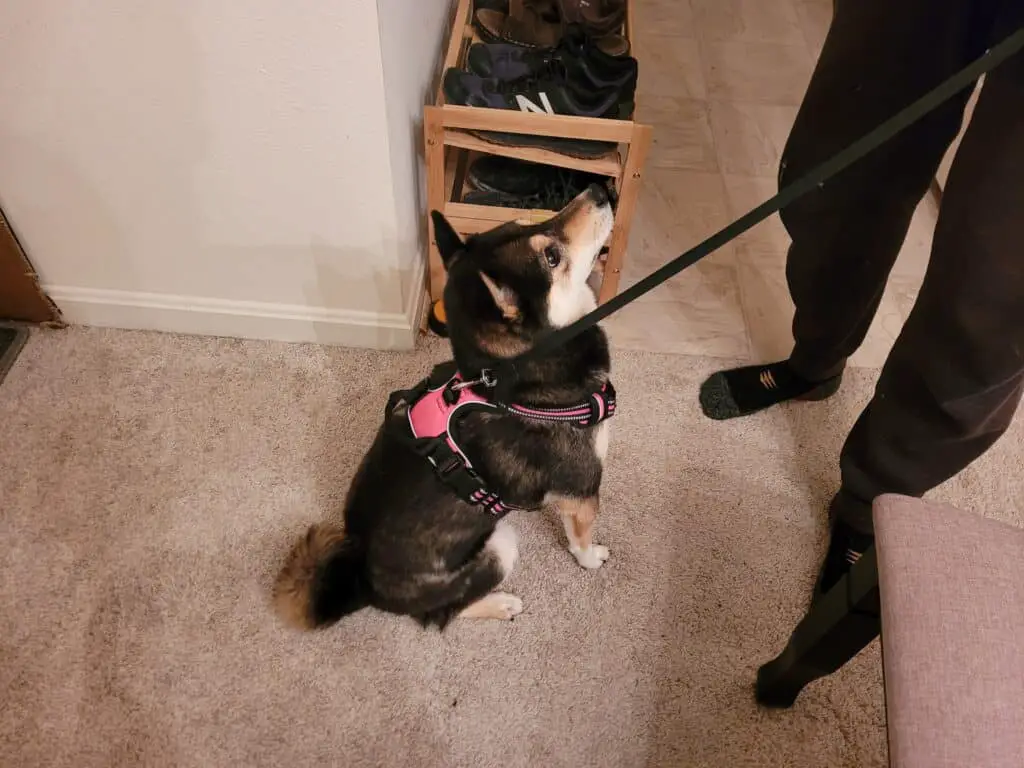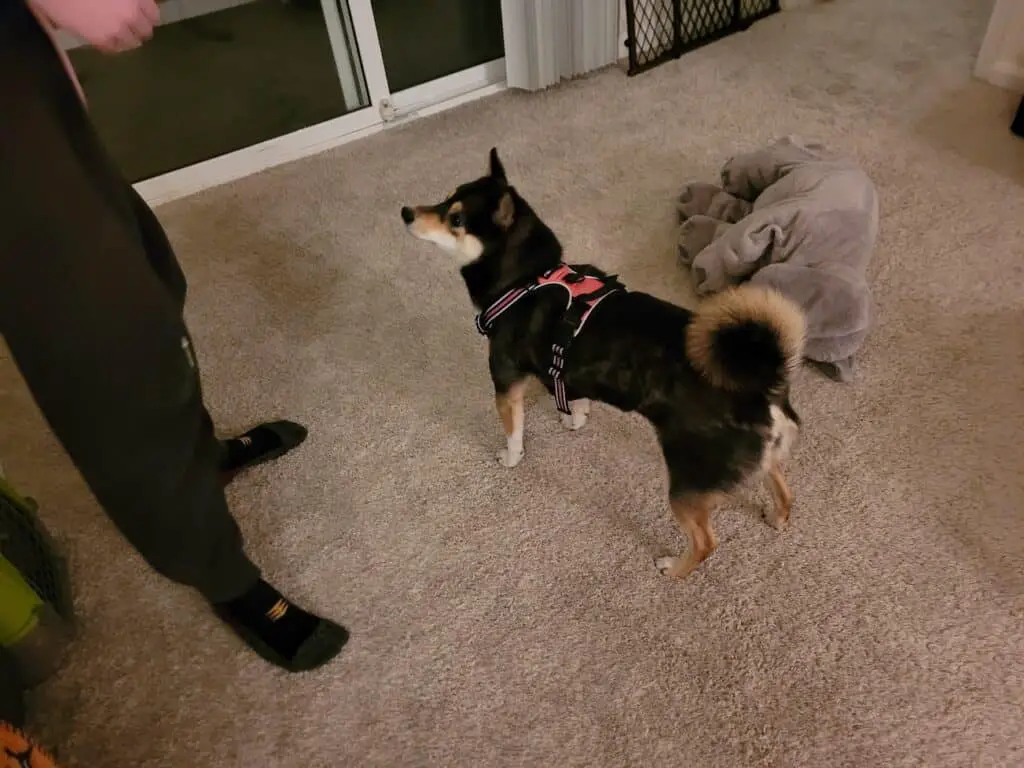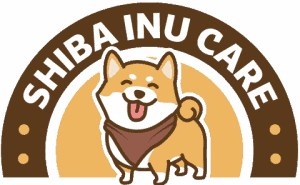This post contains affiliate links.
Leash training is one of those fundamental skills all dogs need, but can be really frustrating when you’re dealing with a stubborn Shiba Inu.
Grab an appropriately sized harness, medium-sized harnesses work best for adult Shiba Inus while puppies need an extra small (xs) harness. Get them used to wearing their harness and gradually work your way to longer and longer walks, starting indoors and slowly transitioning outside.
Leash training is a lot easier when you have a few ground rules to follow, like not letting them drag you around. All of which lead pet owners to ask one question, why is leash training so important for Shiba Inus?

The Reason Leash Training Shiba Inus Is So Important
Shiba Inus are a breed best left on a leash, that’s because they almost unanimously will run away the first chance they get. The reason they run away isn’t that they don’t like you, it’s due to their strong prey drive.
Shibas are a high-energy, alert, hunting breed. They’re easily distracted but loose leaves blowing in the wind, a squirrel crossing the stress, rustling in a nearby bush, or even other pets walking by. Any of which could trigger a Shiba’s prey drive, causing them to run full speed after whatever caught their attention.
When Should I Start Leash Training My Shiba Inu?
Shibas should start leash training at eight weeks old. If your Shiba Inu is younger than eight weeks of age, it’s best to wait and focus on their health. The best time to start training a Shiba Inu over 2 months old is as soon as possible. The longer this breed goes without proper leash training, the harder it’ll be to break bad habits.
What Supplies Should I Have For Leash Training?
If half of leash training is consistent, then the other half is having the right supplies. The right gear will make this foundational step in your Shiba’s life significantly easier. But it’s not just about having the right tool for the job, it’s also about understanding why so many people recommend given gear.
Why It’s Important Shiba Inus Have A Harness
While most dogs are perfectly fine on a collar it’s best to stick to harnesses when possible for Shiba Inus. As Shiba’s age they tend to develop a lot of eye problems, with the most common one being glaucoma. The extra stress and pressure of your Shiba’s eyes from pulling on their collar can agitate their eyes, causing them to develop eye problems sooner.
An Appropriately Sized Dog Harness
With harnesses being so highly recommended for this breed, and the fact they love running away, finding one that properly fits is essential. Thankfully there is a simple rule you can follow for most Shibas when it comes to picking the right harness.
Adult Shiba Inus do best in medium-sized harnesses, while puppies need to start with extra small (xs) sized harnesses. When it comes to adult Shibas, I recommend the Rabbitgoo harness over on Amazon. PoyPet is another great option for those looking for a puppy-sized dog harness.
Just be sure you pick the right size for your pet’s age. Almost every harness on the market has the option to adjust the size and fit, but you shouldn’t expect that to make a harness that’s too big or too small to fit.
A 6-Foot Leash
The primary thing you want when you first start leash training a Shiba Inu is control, and a solid 6-foot leash does the job. As your Shiba gets more comfortable being on a leash, listing to you, and following your commands all with minimal leash pulling, it’s safe to switch over to a retractable leash.
But when you first start training your Shiba, it’s best to stick to something short, durable, and simple. I got this 6-foot leash from TAIDA, it’s cheap, durable, and was more than enough for me when I was first starting out. When you’re ready for it, I grabbed this retractable TUG leash.
A Handful Of Training Treats
Most dogs, including Shiba Inus, are food motivated. Making treats a must for every training session. Most treats will work, but if you plan on regularly training your Shiba Inu I recommend you get a pack of smaller training treats.
They’re specifically made to be given to your pet in higher quantities than other types of treats. My favorite training treats are from Pet Botanics. But if you’d like to do your own research, or see what other types of treats are out there, take a look at our post going over how to pick the best treats for Shiba Inus.
How To Start Leash Training A Shiba Inu

1) Familiarize Your Shiba With Their Leash And Harness
Shiba Inus as a breed aren’t naturally used to being handled. This ranges from playing with their tail, touching their paws, putting their harness on, or even hooking up their leash to take them on a walk. It’s best to let your Shiba investigate their new travel wear, lay their leash and harness on the floor, and let them sniff them for a minute or two. Just be sure not to let them chew on them.
2) Practice Putting Their Harness On
Once your Shiba looks comfortable with their new supplies calmly call them over, with a few treats, and motion to put their harness on. Some Shiba’s may let you put it on with little to no issue, while others will make it a game of cat-and-mouse where you end up chasing them around the house.
Offer your Shiba a treat when they’re near their harness and pet them, slowly transitioning to rewarding them for allowing you to put it on. Once you have their harness on, reward them with treats and praise, then lock any clips your harness comes with to secure it.
For the first minute or two, you should just watch your Shiba walk around and mess with it, but redirect any chewing. If you notice it’s too tight, or too loose, adjust the straps accordingly until it fits your Shiba Inu comfortably.
3) Start Taking Them In Small Steps Around The House
Now that your Shiba is wearing their harness you should guide them around the house. You can do this with commands, toys, or treats – all of them will work. Make sure their harness isn’t impacting their ability to walk. It’s normal for them to be a bit awkward for the first day or two, but if they’re clearly struggling it’s a sign something is wrong. Bounce between using a leash and letting them walk freely.
4) Encourage Your Shiba To Continue With Treats
It’s also common for Shibas to refuse to do anything without being compensated, mainly with treats. It’s perfectly fine to reward your Shiba fairly generously at first, like any other training session. But try not to overdo it, you don’t want your pet to fill up on treats before one of their meals.
5) Slowly Reduce Their Treats Once Their Consistent
When your Shiba starts to get comfortable walking around the house, or apartment, with their harness on it’s time to start waning them off treats.
6) Start Exploring Your Front Yard
Now that your Shiba is comfortable walking around with their harness on indoors it’s time to transition outdoors. For this, I recommend sticking to a familiar environment your Shiba is comfortable with.
Fenced-in backyards work if you have one, but those who live in apartments, condos, or townhouses may not have one. So I recommend starting with a front yard, or a nearby patch of grass. Just double check your Shiba is properly hooked up to their leash. And they aren’t trying to eat the grass.
7) Take Your Shiba Inu To The End Of Your Street
Once you’re confident your Shiba is fine walking around outside on their harness I recommend you start taking mini laps to the end of your street. It’s best to keep these trips short in case your Shiba freaks out or starts to throw a temper tantrum.
8) Steadily Work Your Way Further And Further From Home
When you are confident your Shiba is perfectly fine on their harness it’s time to start taking them on regular walks. This slow and steady approach, while not fast, minimizes the chances of your Shiba lashing out, freaking out, or potentially slipping out of their harness and running away.
How Can I Avoid Leash Pulling?
Most Shiba Inus will pull on their leash while attempting to chase something, due to their prey drive. If left unchecked, that inconsistent tugging and pulling will develop into a bad leash-pulling habit. Semi-frequent sniffing breaks, social interactions, and properly managing their bad behaviors will help you avoid regular leash pulling.
Summary Of Leash Training A Shiba Inu
You should start leash training your Shiba Inu as soon as you get them, preferably at or just after eight weeks of age. While harnesses aren’t strictly required for every breed, they’re heavily recommended for Shiba Inus. They help minimize pulling, minimize the odds of them escaping, and minimize excess stress on their neck and eyes.
Start nice and slow when you decide to begin leash training your Shiba, this is a foundational skill they’ll use daily for the rest of their life so it’s best not to rush things. Make sure your Shiba comfortably fits in their harness, is able to freely walk and move around, and their harness has a snug enough fit that they won’t be able to break loose and run away. After that, it’s all about patience and consistency, like every other type of training.
Frequently Asked Questions
How Do I Train My Dog To Walk Beside Me?
Leash your dog like you would for a walk but take them to either a spacious room in your home or a long hallway. Pick a side, right or left, you’d like your pet to walk on. Once your pet is on that side give them a treat, take a few steps, and repeat. Working your way up to laps indoors before heading outside.
Can Shibas Be Off Leash?
Shiba Inus have a high prey drive, lots of energy, are free-spirited, and love to play. Leading to most Shibas running away once off leash. Unfortunately, chasing after them in a panic and calling their name looks like play to them, so it’s best not to let them off leash. Unless in an enclosed area.
Can Shibas Be Trusted Off Leash?
Shiba Inus can not be trusted off-leash. This high-energy hunting breed has a strong prey drive that at a moment’s notice will have them running away. Shiba Inus are best left on a leash when outdoors. It’s only safe to let a Shiba off leash in an enclosed space, like a dog park or fenced backyard.
